Attached files
| file | filename |
|---|---|
| EX-99.1 - EX-99.1 - Santander Consumer USA Holdings Inc. | a2020q3exhibit991.htm |
| 8-K - 8-K - Santander Consumer USA Holdings Inc. | sc-20201028.htm |
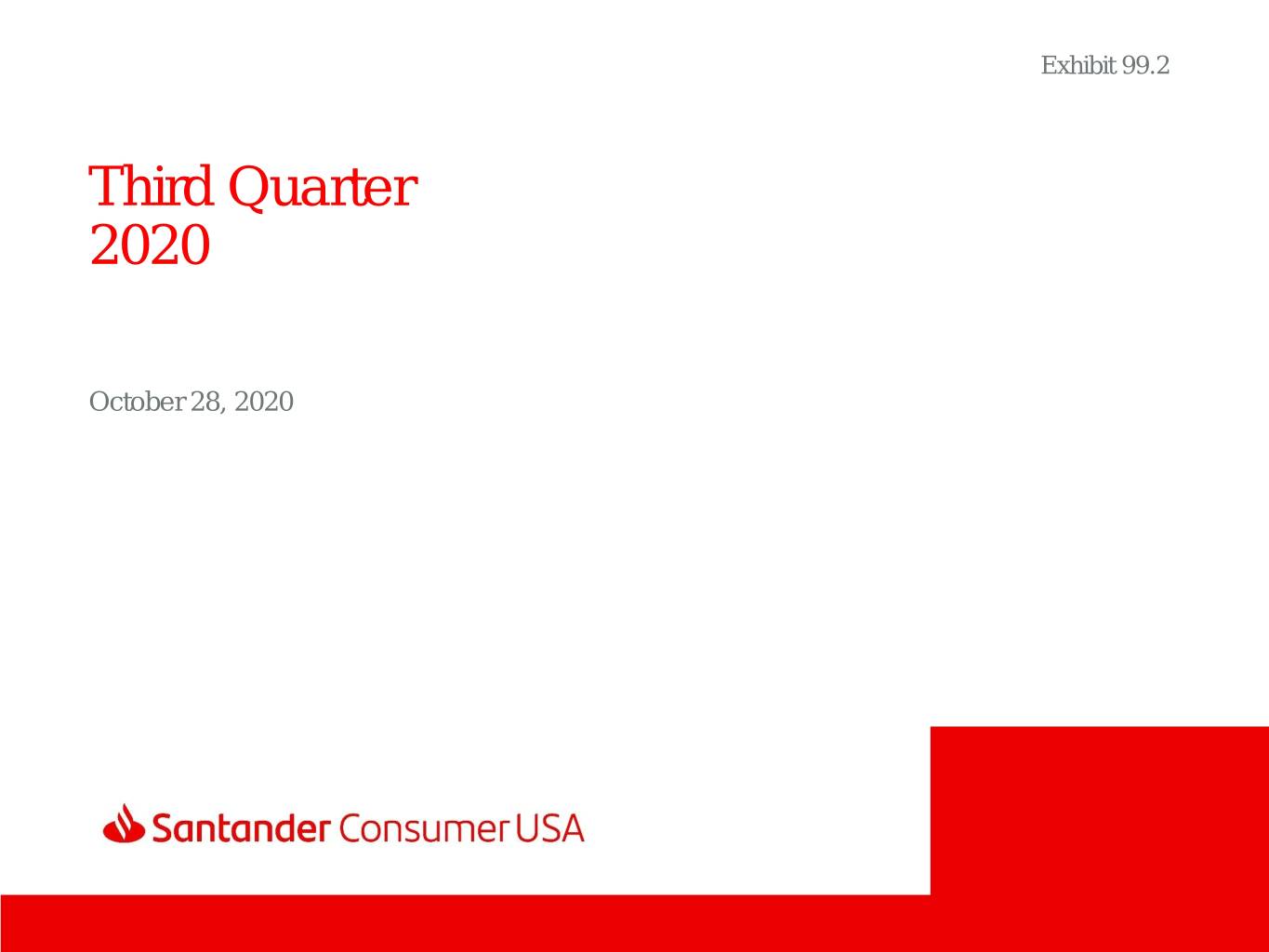
Exhibit 99.2 Third Quarter 2020 October 28, 2020

Forward-Looking Statements statements in this presentation and/or our financial performance to differ IMPORTANT materially from that suggested by the forward-looking statements are (a) the adverse impact of COVID-19 on our business, financial condition, liquidity and results of operations; (b) continually changing federal, state, INFORMATION and local laws and regulations could materially adversely affect our business; (c) adverse economic conditions in the United States and worldwide may negatively impact our results; (d) a reduction in our access to funding; (e) significant risks we face implementing our growth strategy, some of which are outside our control; (f) unexpected costs and delays in connection with exiting our personal lending business; (g) our agreement with FCA US LLC may not result in currently anticipated levels of growth and is subject to certain conditions that could result in termination of the agreement; (h) our business could suffer if we are unsuccessful in developing and maintaining relationships with automobile dealerships; (i) our financial condition, liquidity, and results of operations depend on the credit performance of our loans; (j) loss of our key management or other personnel, or an inability to attract such management and personnel; (k) certain regulations, including but not limited to oversight by the Office of the Comptroller of the Currency, the This presentation contains forward-looking statements within the Consumer Financial Protection Bureau, the European Central Bank, and meaning of the Private Securities Litigation Reform Act of 1995. Any the Federal Reserve, whose oversight and regulation may limit certain of statements about our expectations, beliefs, plans, predictions, forecasts, our activities, including the timing and amount of dividends and other objectives, assumptions, or future events or performance are not limitations on our business; and (l) future changes in our relationship with historical facts and may be forward-looking. These statements are often, SHUSA and Banco Santander that could adversely affect our operations. but not always, made through the use of words or phrases such as If one or more of the factors affecting our forward-looking information and anticipates, believes, can, could, may, predicts, potential, should, will, statements proves incorrect, our actual results, performance or estimates, plans, projects, continuing, ongoing, expects, intends, and achievements could differ materially from those expressed in, or implied similar words or phrases. Although we believe that the expectations by, forward-looking information and statements. Therefore, we caution reflected in these forward-looking statements are reasonable, these the reader not to place undue reliance on any forward-looking statements are not guarantees of future performance and involve risks information or statements. The effect of these factors is difficult to and uncertainties that are subject to change based on various important predict. Factors other than these also could adversely affect our results, factors, some of which are beyond our control. For additional discussion and the reader should not consider these factors to be a complete set of of these risks, refer to the section entitled Risk Factors and elsewhere in all potential risks or uncertainties as new factors emerge from time to our Annual Report on Form 10-K for the year ended December 31, 2019, time. Any forward-looking statements only speak as of the date of this our subsequent Quarterly Reports on Form 10-Q or Current Reports on document, and we undertake no obligation to update any forward-looking Form 8-K, or other applicable documents that are filed or furnished with information or statements, whether written or oral, to reflect any change, the U.S. Securities and Exchange Commission (collectively, our "SEC except as required by law. All forward-looking statements attributable to filings"). Among the factors that could cause the forward-looking us are expressly qualified by these cautionary statements. 2
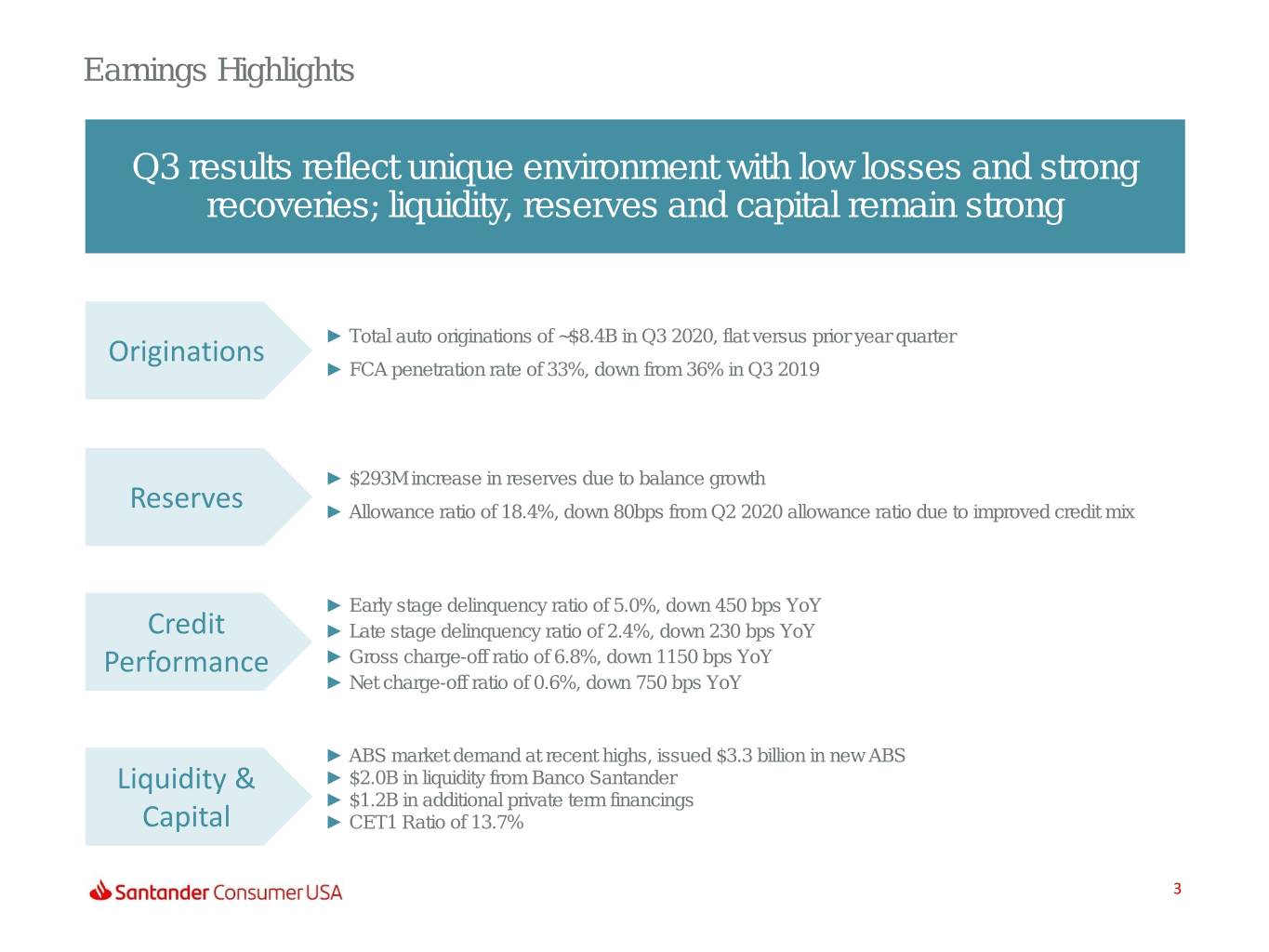
Earnings Highlights Q3 results reflect unique environment with low losses and strong recoveries; liquidity, reserves and capital remain strong ► Total auto originations of ~$8.4B in Q3 2020, flat versus prior year quarter Originations ► FCA penetration rate of 33%, down from 36% in Q3 2019 ► $293M increase in reserves due to balance growth Reserves ► Allowance ratio of 18.4%, down 80bps from Q2 2020 allowance ratio due to improved credit mix ► Early stage delinquency ratio of 5.0%, down 450 bps YoY Credit ► Late stage delinquency ratio of 2.4%, down 230 bps YoY Performance ► Gross charge-off ratio of 6.8%, down 1150 bps YoY ► Net charge-off ratio of 0.6%, down 750 bps YoY ► ABS market demand at recent highs, issued $3.3 billion in new ABS Liquidity & ► $2.0B in liquidity from Banco Santander ► $1.2B in additional private term financings Capital ► CET1 Ratio of 13.7% 3

Economic Indicators Consumer Confidence1 138.4 119.8 125.1 103.0 104.1 101.8 Consumer confidence index remains low due to the 79.7 86.0 70.3 economic impact of the pandemic 59.8 53.1 48.5 45.4 U.S. Unemployment Statistics2 14.7% Unemployment rate of 7.9% in September decreased 9.8% 9.5% 9.0% from 14.7% in April when the impact of stay-at-home 7.8% orders were more severe 7.2% 6.1% 5.9% 7.9% 5.0% 5.0% 4.2% 3.7% 3.5% U.S. GDP QoQ Change3 3.1% 2.4% 2.9% 2.1% 2.9% 3.2% 3.4% 2.1% -0.3% 1.2% 1.5% US GDP decreased 31% in Q2 2020 vs Q1 2019 due to -3.3% the impact of COVID-19 -31.4% Sep Sep Sep Sep Sep Sep Sep Sep Sep Sep Sep Sep Sep Sep 07 08 09 10 11 12 13 14 15 16 17 18 19 20 1 The Conference Board’s consumer confidence index, monthly data as of September 30, 2020 4 2 U.S. Bureau of Labor Statistics, monthly data as of September 30, 2020 3 U.S. Bureau of Economic Analysis, quarterly lagged data as of June 30, 2020

Auto Industry Overview New Vehicle SAAR1 17.3 17.2 17.1 16.6 17.0 Auto sales of 17.0M, up 31% QoQ as dealerships 13.0 and manufacturer sales increased after the shutdowns caused by COVID-19 11.4 Used Vehicle SAAR2 39.2 39.8 39.8 40.0 36.0 38.0 32.0 Used auto sales of 38.0M, up 6% QoQ Used Vehicle Price Indices3 161.2 Manheim 149.3 141.9 140.5 139.9 141.1 Used vehicle prices increased to record levels 136.0 due to demand and lower supply 139.5 JDP 126.8 122.0 121.8 121.6 118.4 117.9 1Q 2019 2Q 2019 3Q 2019 4Q 2019 1Q 2020 2Q 2020 3Q 2020 1 U.S. Bureau of Economic Analysis, Light Weight Vehicle Sales: Autos and Light Trucks, monthly data as of September 30, 2020 5 2 Cox Automotive, 13-Month Rolling Used-Vehicle SAAR, monthly data as of September 30, 2020 3 Manheim, Inc.; Indexed to a basis of 100 at 1995 levels; JD Power Used-Vehicle Price Index (not seasonally adjusted), both monthly, quarter end
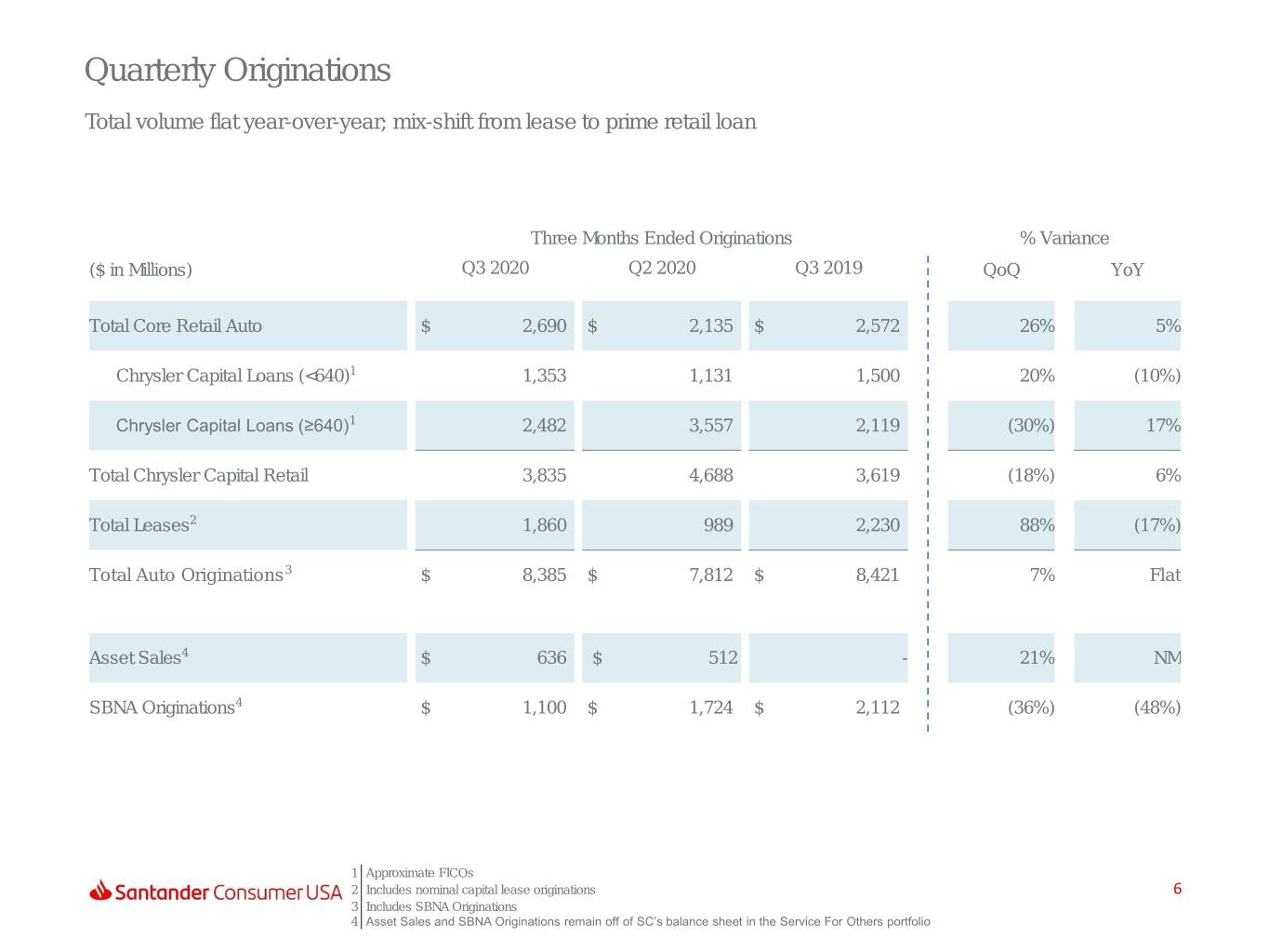
Quarterly Originations Total volume flat year-over-year; mix-shift from lease to prime retail loan Three Months Ended Originations % Variance ($ in Millions) Q3 2020 Q2 2020 Q3 2019 QoQ YoY Total Core Retail Auto $ 2,690 $ 2,135 $ 2,572 26% 5% Chrysler Capital Loans (<640)1 1,353 1,131 1,500 20% (10%) Chrysler Capital Loans (≥640)1 2,482 3,557 2,119 (30%) 17% Total Chrysler Capital Retail 3,835 4,688 3,619 (18%) 6% Total Leases2 1,860 989 2,230 88% (17%) Total Auto Originations3 $ 8,385 $ 7,812 $ 8,421 7% Flat Asset Sales4 $ 636 $ 512 - 21% NM SBNA Originations4 $ 1,100 $ 1,724 $ 2,112 (36%) (48%) 1 Approximate FICOs 2 Includes nominal capital lease originations 6 3 Includes SBNA Originations 4 Asset Sales and SBNA Originations remain off of SC’s balance sheet in the Service For Others portfolio

Year-to-Date Monthly Originations Core Retail Auto ($ in Millions) Chrysler Lease ($ in Millions)1 $1,200 $1,000 $1,000 $800 $800 $600 $600 $400 $400 $200 $200 $0 $0 Jan Feb Mar Apr May Jun Jul Aug Sep Jan Feb Mar Apr May Jun Jul Aug Sep YoY -4% -14% -17% -44% -8% 23% 8% -6% 13% YoY 14% 17% -18% -73% -64% -48% -26% -21% 0% Chrysler Capital Loans, <6401 ($ in Millions) Chrysler Capital Loans, ≥6401 ($ in Millions) $600 $1,400 $500 $1,200 $1,000 $400 $800 $300 $600 $200 $400 $100 $200 $0 $0 Jan Feb Mar Apr May Jun Jul Aug Sep Jan Feb Mar Apr May Jun Jul Aug Sep YoY -7% -13% -12% -40% -24% -5% -11% -19% 2% YoY 22% 22% 45% 125% 79% 45% 23% 6% 23% 1 Approximate FICOs 2019 2020 7

Fiat Chrysler (FCA) Relationship SC continues to partner with FCA to drive sales • Continue to support both retail and lease incentives • Penetration rate normalizing following 0% APR incentives due to COVID-19 FCA Sales1 (units in ‘000s) Chrysler Penetration Rate2 1,661 37.1% 35.7% 35.8% 34.5% 1,321 32.5% 565 507 367 3Q19 2Q20 3Q20 YTD'19 YTD'20 3Q19 2Q20 3Q20 YTD'19 YTD'20 1 FCA filings; sales as reported on 10/01/2020 8 2 Auto loans and leases financed by Chrysler Capital

Serviced for Others (SFO) Platform Serviced for Others Balances, End of Period ($ in Millions) Balances Up QoQ $11,511 $10,727 $10,414 $10,331 $9,979 17% 12% 15% 15% Serviced for others balance growth 20% driven by prime originations from FCA and the SBNA program 88% 83% 85% 85% Off-balance sheet securitization of 80% $636M also added to the SFO platform 3Q19 4Q19 1Q20 2Q20 3Q20 Related Party 3rd Party 9

Diversified Funding and Liquidity Total unutilized capacity of approximately $12 billion at the end of Q3 2020 Asset-Backed Securities1 ($ in Billions) Financings ($ in Billions) 1 Revolving 2 17.9 18.8 Amortizing 11.7 12.1 9.6 8.6 7.8 9.3 Unused Used 3.9 2.8 Q2 2020 Q3 2020 Q2 2020 Q3 2020 Q2 2020 Q3 2020 ► $3.3B of new issuance in Q3: 2 SDART ► ~$1.2B of private term financings in Q3 ► 77% unused capacity on warehouse lines from 12 lenders Santander2 ($ in Billions) Asset Sales ($ in Billions) 14.2 2.2 12.2 0.5 2.5 0.5 Revolving 0.5 1.7 2.5 Asset Sales Contingent 0.6 11.2 9.2 Term 1.7 SBNA 1.1 Originations Q2 2020 Q3 2020 Q2 2020 Q3 2020 ► $2.0B in new term funding in Q3 ► Off-balance sheet securitization of $636M ► $3.0B in unutilized revolving and contingent liquidity 1 Total outstanding as of September 30, 2020 10 2 Total commitment as of September 30, 2020

Q3 2020 Financial Results Three Months Ended (Unaudited, Dollars in Thousands, except per share) September 30, 2020 June 30, 2020 September 30, 2019 Interest on finance receivables and loans $ 1,300,694 $ 1,236,600 $ 1,273,022 Net leased vehicle income 257,984 126,688 250,109 Other finance and interest income 2,146 2,657 9,926 Interest expense 292,118 308,982 335,212 Net finance and other interest income $ 1,268,706 $ 1,056,963 $ 1,197,845 Credit Loss Expense 340,548 861,896 566,849 Profit sharing 30,414 11,530 18,125 Total other income 28,509 (46,393) 31,293 Total operating expenses 263,662 266,679 329,470 Income before tax $ 662,591 $ (129,535) $ 314,694 Income tax expense 172,476 (32,857) 82,156 Net income $ 490,115 $ (96,678) $ 232,538 Diluted EPS ($) $ 1.58 $ (0.30) $ 0.67 Average total assets $ 47,979,008 $ 46,876,726 $ 46,915,965 Average managed assets $ 62,662,686 $ 61,001,767 $ 57,379,308 11

Customer Relief Loan Deferrals Since the beginning of the pandemic through the end of the third quarter, ~645,000 unique accounts received deferrals 86% of unique accounts that received deferrals have had those deferrals expire 80% of these accounts remain <30 days past due Percent Deferred 27.0% Pandemic September 2020 Balance 30% Peak Ending Deferral Status Units % (in '000s) 25% Active 89,000 14% $ 1,690,000 17.7% 20% As of Q2 Expired and <30 DPD 427,000 66% $ 7,730,000 15% Expired and >30 DPD 84,000 13% $ 1,520,000 10% 4.5% As of Q3 Paid Off (cumulative) 33,000 5% $ 320,000 5% % ofAccounts Active% Charge Off (cumulative) 12,000 2% $ 220,000 0% Unique Accounts Deferred 645,000 100% $ 11,480,000 * Approximate data from March 1, 2020 – September 30, 2020 12

Quarterly Delinquency & Loss Delinquency Ratios: 30-59 Days Delinquent, RICs, HFI COVID-19 hardship relief programs and strong payment rates led to lower delinquencies and charge- 9.5% 9.7% 8.3% offs during the period 4.3% 5.0% Early stage delinquencies decreased 450 bps YoY Delinquency Ratios: >59 Days Delinquent, RICs, HFI 5.1% 4.7% 4.6% 2.4% 2.4% Late stage delinquencies decreased 230 bps YoY Gross Charge-off Rates 18.3% 17.3% 15.5% 11.1% 6.8% Gross charge-off rate decreased more than 11 percentage points YoY SC Recovery Rates1 (% of Gross Loss) 55.9% 52.2% 91.4% 50.1% 45.7% SC’s Q3 recovery rate of 91% driven by record wholesale prices at auction and low gross losses for the quarter Net Charge-off Rates2 8.1% 8.3% 7.7% 6.0% Net charge-off rate decreased 750 bps YoY 0.6% Q3 2019 Q4 2019 1Q 2020 2Q 2020 Q3 2020 1 Recovery Rate – Per the financial statements includes insurance proceeds, bankruptcy/deficiency sales, and timing impacts 13 2 Net Charge-off rates on retail installment contracts, held for investment

Loss and Recovery Ratios (Annualized) Gross Charge-off Ratio (%) Recovery Rates (% of Gross Loss) 25.0% 125.0% 20.0% 100.0% 15.0% 75.0% 10.0% 50.0% 5.0% 25.0% 0.0% 0.0% Jan Feb Mar Apr May Jun Jul Aug Sep Oct Nov Dec Jan Feb Mar Apr May Jun Jul Aug Sep Oct Nov Dec 2019 22.3 19.1 17.0 16.1 16.1 15.8 17.9 18.4 18.5 18.3 17.1 16.1 2019 49.0 54.6 66.1 62.5 62.4 56.0 55.2 59.2 53.2 52.9 57.5 46.2 2020 17.2 15.6 13.7 12.9 12.6 8.1 6.7 5.5 7.9 2020 46.0 53.0 52.1 32.1 49.1 62.1 81.7 126.1 76.4 Net Charge-off Ratio (%) 15.0% 12.0% 9.0% 6.0% 3.0% 0.0% -3.0% Jan Feb Mar Apr May Jun Jul Aug Sep Oct Nov Dec 2019 11.3 8.7 5.8 6.1 6.1 7.0 8.0 7.5 8.6 8.6 7.3 8.7 2020 9.3 7.3 6.6 8.7 6.4 3.1 1.2 -1.4 1.9 2019 2020 14

Loss Detail Q3 2019 to Q3 2020: Net Charge-off Walk, ($ in Billions) Net charge-offs for RICs decreased ~$546M versus prior year quarter to $592 $72 $46M ($446) $72M increase in losses due to higher loan balances $446M decrease due to lower gross charge off rate and $172M decrease due ($172) improved recovery performance $46 Q3 2019 Balance Gross Loss Recoveries Q3 2020 Performance & Other 15

Reserves 1 Q2 2020 to Q3 2020 Allowance for Credit Loss Walk (RICs, HFI $ in Millions) ($181) Allowance for credit loss increased by $293M QoQ $474 $474M increase due to balance growth, offset by portfolio and other factors including $6,149 $6,149 macro economic outlook $5,856 $5,856 2Q 2020 Portfolio Changes - Portfolio & Economic 3Q 2020 Volume Factors $2,000Credit Loss Expense and Allowance Ratio ($ in Millions) 25.0% $1,800 19.2% $1,600 17.8% 18.4% 20.0% $1,400 $1,200 15.0% Credit loss expense decreased $226M $908 YoY driven by lower net charge-offs $1,000 10.5% 9.9% $861 $800 10.0% $567 $545 $600 Allowance to loans ratio decreased 80 bps $341 driven by asset mix $400 5.0% $200 $- 0.0% Q3 2019 Q4 2019 Q1 2020 Q2 2020 Q3 2020 Credit loss expense Allowance Ratio 1 Allowance for credit loss related to retail installment contracts, held for investment 16
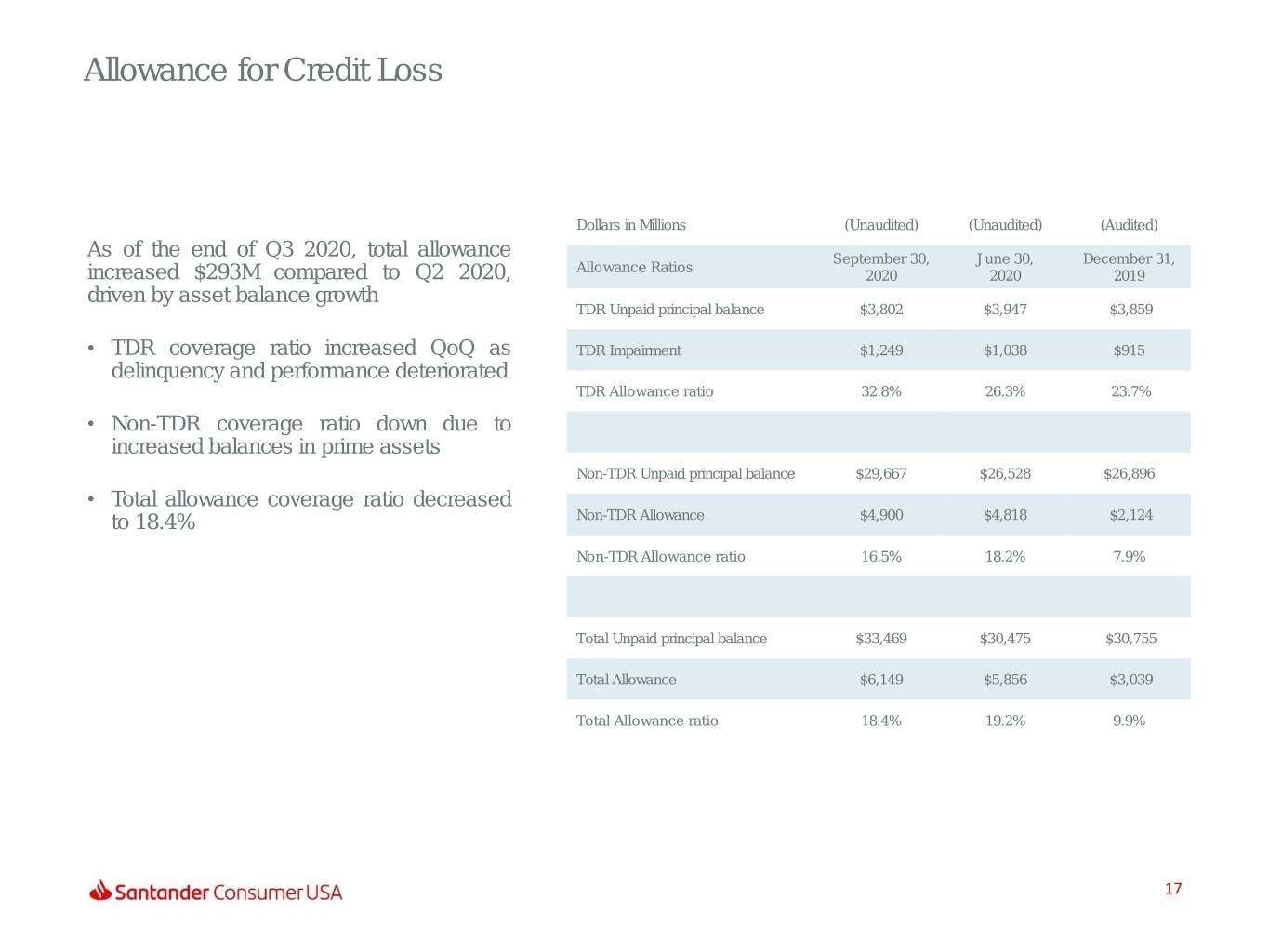
Allowance for Credit Loss Dollars in Millions (Unaudited) (Unaudited) (Audited) As of the end of Q3 2020, total allowance September 30, June 30, December 31, Allowance Ratios increased $293M compared to Q2 2020, 2020 2020 2019 driven by asset balance growth TDR Unpaid principal balance $3,802 $3,947 $3,859 • TDR coverage ratio increased QoQ as TDR Impairment $1,249 $1,038 $915 delinquency and performance deteriorated TDR Allowance ratio 32.8% 26.3% 23.7% • Non-TDR coverage ratio down due to increased balances in prime assets Non-TDR Unpaid principal balance $29,667 $26,528 $26,896 • Total allowance coverage ratio decreased to 18.4% Non-TDR Allowance $4,900 $4,818 $2,124 Non-TDR Allowance ratio 16.5% 18.2% 7.9% Total Unpaid principal balance $33,469 $30,475 $30,755 Total Allowance $6,149 $5,856 $3,039 Total Allowance ratio 18.4% 19.2% 9.9% 17

Expense Management Operating expenses Operating Expenses ($ in Millions) totaled $264M, $400 7.0% $350 $329 $309 6.0% expense ratio down $300 $283 $267 $264 5.0% 60bps YoY $250 4.0% $200 3.0% $150 2.3% 2.1% Operating expenses decreased $65M 1.9% 1.7% 1.7% 2.0% YoY primarily driven by lower $100 repossession expense and other 1.0% expenses $50 $- 0.0% Q3 2019 Q4 2019 Q1 2020 Q2 2020 Q3 2020 Operating Expense Expense Ratio 18

CET1 Ratio 1 Common Equity Tier 1 Capital Ratio Strong capital $120,000 18.0% 15.4% 16.0% 14.8% base $110,000 13.8% 13.7% 13.4% 14.0% $100,000 12.0% SC maintains strong capital levels in addition to its loan loss reserves 10.0% $90,000 8.0% Under the Federal Reserve's interim policy, SC cannot pay a dividend or buy $80,000 6.0% back shares in Q4 4.0% $70,000 2.0% $60,000 0.0% Q3 2019 Q4 2019 Q1 2020 Q2 2020 Q3 2020 Tier 1 common capital $7,226 $7,193 $6,726 $6,574 $6,834 Risk weighted assets 2 $46,870 $48,762 $48,830 $48,998 $49,883 CET1 15.4% 14.8% 13.8% 13.4% 13.7% 1 CET1 is calculated under Basel III regulations required as of January 1, 2015. Please see the appendix for further details related to CECL phase-in impact. 19 2 Under the banking agencies' risk-based capital guidelines, assets and credit equivalent amounts of derivatives and off-balance sheet exposures are assigned to .broad risk .categories. The aggregate dollar amount in each risk category is multiplied by the associated risk weight of the category. The resulting weighted values are added together with the measure for market risk, resulting in the Company's and the Bank's total Risk weighted assets

Appendix
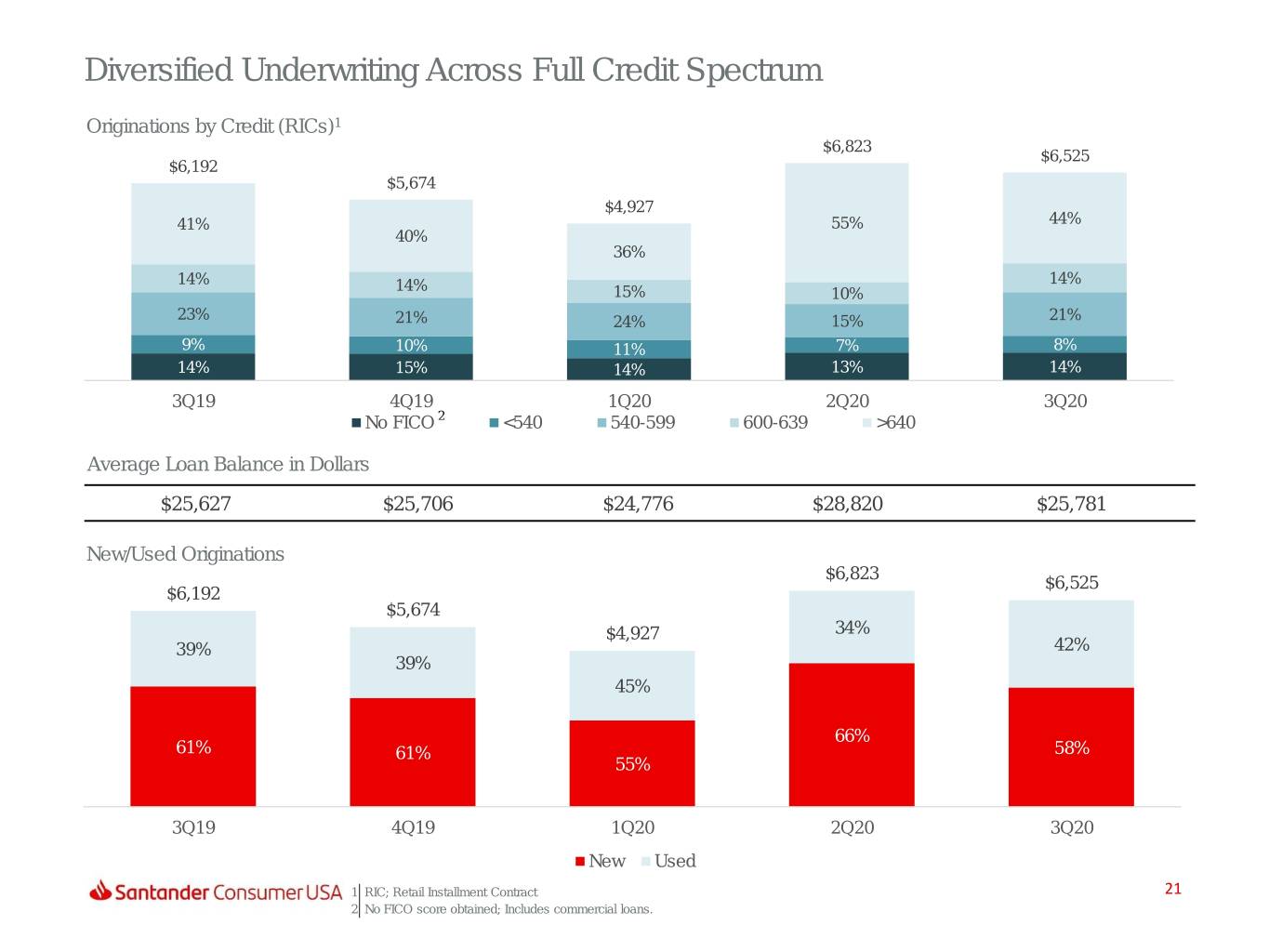
Diversified Underwriting Across Full Credit Spectrum Originations by Credit (RICs)1 $6,823 $6,525 $6,192 $5,674 $4,927 41% 55% 44% 40% 36% 14% 14% 14% 15% 10% 23% 21% 24% 15% 21% 9% 10% 11% 7% 8% 14% 15% 14% 13% 14% 3Q19 4Q19 1Q20 2Q20 3Q20 No FICO 2 <540 540-599 600-639 >640 Average Loan Balance in Dollars $25,627 $25,706 $24,776 $28,820 $25,781 New/Used Originations $6,823 $6,525 $6,192 $5,674 $4,927 34% 39% 42% 39% 45% 66% 61% 61% 58% 55% 3Q19 4Q19 1Q20 2Q20 3Q20 New Used 1 RIC; Retail Installment Contract 21 2 No FICO score obtained; Includes commercial loans.

Heldfor Investment Credit Trends Retail Installment RetailInstallment Contracts 2.2% Commercial 2.4% Q3 2019 2.5% 2.6% 2.5% 1 10.6% Unknown 1 10.0% Held for investment; excludes assets held for sale forheld assets excludes investment; Held for 12.4% Q4 2019 10.1% 10.1% 17.9% 16.9% <540 16.7% 16.7% Q1 2020 15.3% 32.9% 540-599 31.9% 31.9% 32.6% 30.8% Q2 2020 19.0% 600-639 19.0% 18.9% 19.2% 18.3% Q3 2020 17.4% >=640 19.8% 17.5% 18.8% 23.0% 22

Excluding Personal Lending Detail Personal lending earned of $49M before operating expenses and taxes in Q3 2020 Three Months Ended, (Unaudited, Dollars in Thousands) September 30, 2020 June 30, 2020 September 30, 2019 Excluding Excluding Excluding Personal Personal Personal Total Personal Total Personal Total Personal Lending Lending Lending Lending Lending Lending Interest on finance receivables and loans $ 1,300,694 $ 79,359 $ 1,221,335 $ 1,236,600 $ 83,808 $ 1,152,792 $ 1,273,022 $ 88,449 $ 1,184,573 Net leased vehicle income 257,984 - 257,984 126,688 - 126,688 250,109 - 250,109 Other finance and interest income 2,146 - 2,146 2,657 - 2,657 9,926 - 9,926 Interest expense 292,118 10,286 281,832 308,982 11,016 297,966 335,212 11,419 323,793 Net finance and other interest income $ 1,268,706 $ 69,073 $ 1,199,633 $ 1,056,963 $ 72,792 $ 984,171 $ 1,197,845 $ 77,030 $ 1,120,815 Provision for credit losses $ 340,548 $ (23) $ 340,571 $ 861,896 $ - $ 861,896 $ 566,849 $ (14) $ 566,863 Profit sharing 30,414 3,607 26,807 11,530 6,587 4,943 18,125 - 18,125 Investment gains (losses), net1 $ (68,989) $ (56,598) $ (12,391) $ (147,582) $ (121,642) $ (25,940) $ (86,397) $ (87,454) $ 1,057 Servicing fee income 18,574 - 18,574 19,120 - 19,120 21,447 - 21,447 Fees, commissions and other 78,924 40,140 38,784 82,069 36,911 45,158 96,243 48,097 48,146 Total other income $ 28,509 $ (16,458) $ 44,967 $ (46,393) $ (84,731) $ 38,338 $ 31,293 $ (39,357) $ 70,650 Average gross individually acquired retail installment $ 30,768,423 - $ 31,193,215 - $ 29,450,778 - contracts, held for investment and held for sale Average gross personal loans - $ 1,413,021 - $ 1,307,609 - $ 1,343,098 Average gross operating leases $ 17,735,640 $ - $ 17,492,255 $ - $ 16,902,932 $ - 1 The current period losses were primarily driven by $57 million of lower of cost or market adjustments related to the held for sale personal 23 ..lending portfolio, comprised of $81 million in customer default activity, and a $24 million favorable market discount.

Reconciliation of Non-GAAP Measures Three Months Ended (Unaudited, Dollars in Thousands) Sep 30, 2020 Jun 30, 2020 Mar 31, 2020 Dec 31, 2019 Sep 30, 2019 Total equity $5,094,812 $4,895,465 $5,146,103 $7,318,620 $7,345,202 Deduct: Goodwill and intangibles 136,397 127,215 121,879 116,828 110,683 Tangible common equity $4,958,415 $4,768,250 $5,024,224 $7,201,792 $7,234,519 Total assets $48,448,921 $47,268,695 $47,106,931 $48,933,529 $47,279,015 Deduct: Goodwill and intangibles 136,397 127,215 121,879 116,828 110,683 Tangible assets $48,312,524 $47,141,480 $46,985,052 $48,816,701 $47,168,332 Equity to assets ratio 10.5% 10.4% 10.9% 15.0% 15.5% Tangible common equity to tangible assets 10.3% 10.1% 10.7% 14.8% 15.3% Total equity $5,094,812 $4,895,465 $5,146,103 $7,318,620 $7,345,202 Add: Adjustment due to CECL capital relief (c) 1,842,536 1,769,430 1,669,466 - - Deduct: Goodwill and other intangible assets, net of DTL 159,907 154,943 153,712 152,756 150,644 Deduct: Accumulated other comprehensive income, net (56,882) (63,705) (63,655) (26,693) (31,836) Tier 1 common capital $6,834,323 $6,573,657 $6,725,512 $7,192,557 $7,226,394 Risk weighted assets (a)(c) $49,882,540 $48,997,902 $48,829,941 $48,761,825 $46,870,019 Common Equity Tier 1 capital ratio (b)(c ) 13.7% 13.4% 13.8% 14.8% 15.4% a Under the banking agencies’ risk-based capital guidelines, assets and credit equivalent amounts of derivatives and off-balance sheet exposures are assigned to broad risk categories. The aggregate dollar amount in each risk category is multiplied by the associated risk weight of the category. The resulting weighted values are added together with the measure for market risk, resulting in the Company’s total Risk weighted assets. b CET1 is calculated under Basel III regulations required since January 1, 2015. The fully phased-in capital ratios are non-GAAP financial measures. c As described in our 2019 annual report on Form 10-K, on January 1, 2020, we adopted ASU 2016-13, Financial Instruments -Credit Losses (“CECL”), which upon adoption resulted in a reduction to our opening retained earnings balance, net of income tax, and increase to the allowance for credit losses of approximately $2 billion. As also described in our 2019 10-K, the U.S. banking agencies in December 2018 had approved a final rule to address the impact of CECL on regulatory capital by allowing banking organizations, including the Company, the option to phase in the day-one impact of CECL until the first quarter of 2023. In March 2020, the U.S. banking agencies issued an interim final rule that provides banking organizations with an alternative option to delay for two years an estimate of CECL’s effect on regulatory capital, relative to the incurred loss methodology’s effect on regulatory capital, followed by a three-year transition period. The Company is electing this alternative option instead of the one described in the December 2018 rule. 24

Thank You Our purpose is to help people and business prosper. Our culture is based on believing that everything we do should be:
